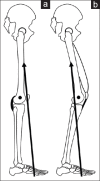Management of the Knee Problems in Spastic Cerebral Palsy
- PMID: 30905982
- PMCID: PMC6394172
- DOI: 10.4103/ortho.IJOrtho_339_17
Management of the Knee Problems in Spastic Cerebral Palsy
Abstract
Two common knee problems in cerebral palsy are increased knee flexion during stance phase and reduced knee flexion during the swing phase of gait. We reviewed the recent literature and based on that, we formed this review. Hamstring spasticity, quadriceps weakness, soleus weakness, and lever-arm dysfunction are few factors which lead to increased knee flexion during stance phase. Rectus spasticity diminishes knee flexion in the swing. Resulting gait-stiff knee gait interferes with ground clearance. Both gait patterns result into esthetically poor gait and increased energy consumption. Knee flexion gait may lead to pain in the knee. Natural history of knee flexion gait suggests deterioration over time. In the early stage, these gait abnormalities are managed by nonoperative treatment. Cases in which nonoperative measures fail or advance cases need surgical treatment. Various variables which are taken into consideration before selecting a particular treatment option are described. We also present an algorithm for decision-making. Nonsurgical options and surgical procedures are discussed.
Keywords: Cerebral palsy; diplegia; knee flexion stiff knee.
Conflict of interest statement
There are no conflicts of interest.
Figures







References
-
- Gage JR. Surgical treatment of knee dysfunction in cerebral palsy. Clin Orthop Relat Res. 1990;253:45–54. - PubMed
-
- Arnold AS, Liu MQ, Schwartz MH, Ounpuu S, Delp SL. The role of estimating muscle-tendon lengths and velocities of the hamstrings in the evaluation and treatment of crouch gait. Gait Posture. 2006;23:273–81. - PubMed
-
- Arnold AS, Anderson FC, Pandy MG, Delp SL. Muscular contributions to hip and knee extension during the single limb stance phase of normal gait: A framework for investigating the causes of crouch gait. J Biomech. 2005;38:2181–9. - PubMed
-
- Gage JR, Novacheck TF. An update on the treatment of gait problems in cerebral palsy. J Pediatr Orthop B. 2001;10:265–74. - PubMed
LinkOut - more resources
Full Text Sources
